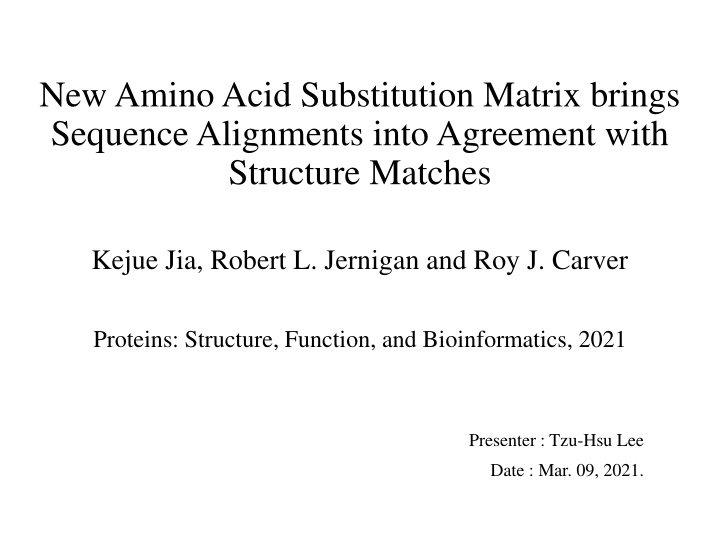
Amino Acid Substitution Matrix for Enhanced Sequence Matching
Explore how a new amino acid substitution matrix improves sequence alignments to better match protein structures. Discover the significant gains in agreement between sequences and structures, particularly in detecting homology for challenging protein sequences.
Download Presentation

Please find below an Image/Link to download the presentation.
The content on the website is provided AS IS for your information and personal use only. It may not be sold, licensed, or shared on other websites without obtaining consent from the author. If you encounter any issues during the download, it is possible that the publisher has removed the file from their server.
You are allowed to download the files provided on this website for personal or commercial use, subject to the condition that they are used lawfully. All files are the property of their respective owners.
The content on the website is provided AS IS for your information and personal use only. It may not be sold, licensed, or shared on other websites without obtaining consent from the author.
E N D
Presentation Transcript
New Amino Acid Substitution Matrix brings Sequence Alignments into Agreement with Structure Matches Kejue Jia, Robert L. Jernigan and Roy J. Carver Proteins: Structure, Function, and Bioinformatics, 2021 Presenter: Tzu-Hsu Lee Date : Mar. 09, 2021.
Abstract(1/2) Protein sequence matching presently fails to identify many structures that are highly similar, even when they are known to have the same function. The high packing densities in globular proteins lead to interdependent substitutions, which have not previously been considered for amino acid similarities. At present, sequence matching compares sequences based only upon the similarities of single amino acids, ignoring the fact that in densely packed protein, there are additional conservative substitutions representing exchanges between two interacting amino acids, such as a small-large pair changing to a large-small pair substitutions that are not individually so conservative.
Abstract(2/2) Here we show that including information for such pairs of substitutions yields improved sequence matches, and that these yield significant gains in the agreements between sequence alignments and structure matches of the same protein pair. The result shows sequence segments matched where structure segments are aligned. There are gains for all 2002 collected cases where the sequence alignments that were not previously congruent with the structure matches. Our results also demonstrate a significant gain in detecting homology for twilight zone protein sequences. The amino acid substitution metrics derived have many other potential applications, for annotations, protein design, mutagenesis design, and empirical potential derivation.
Datasets(1/2) Training set : Pfam Test set : 1. CATH database : contains 4184 homolog families with a total of 8901 protein sequences in CATHS20. 2. SCOP database : contains 1454 homolog families and a total of 4066 sequences in ASTRAL20.
Extract Coevolution Correlations from Multiple Sequence Alignments Using 2320 Pfam MSAs, in each MSA, only ungapped positions are considered in the calculation. Mutual information (between two positions) : where q = 21, is the number of amino acid types. f(??) is the frequency of a single amino acid type A observed at position i. f(??, ??) is the joint frequency for observing the co-occurrence of two amino acid types A and B at positions i and j.
Derive a New Matrix from Contextual Substitutions where f(A, B) is the joint frequencies and f(A)f(B) are the expected single amino acid type frequencies. is a scalar factor .
